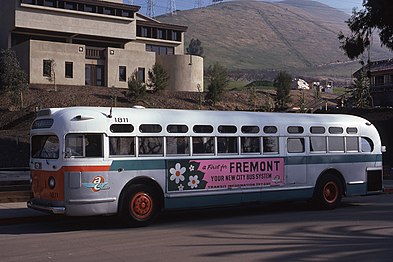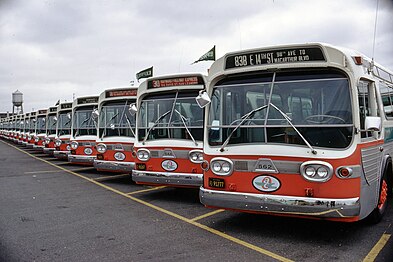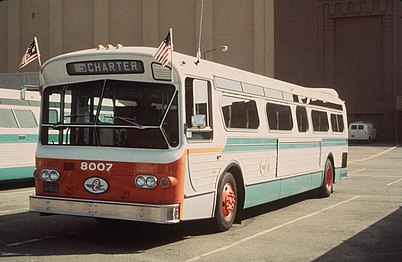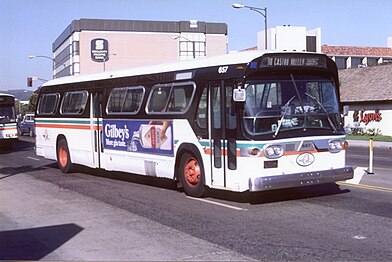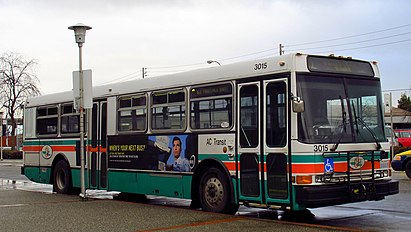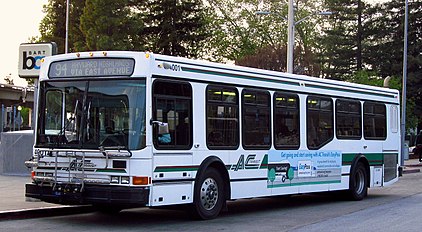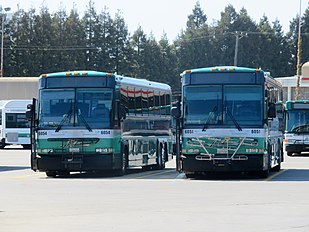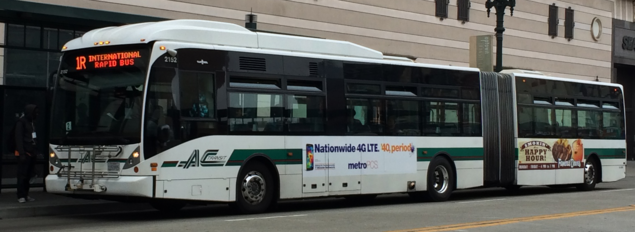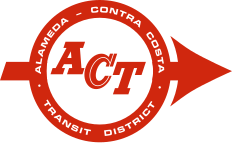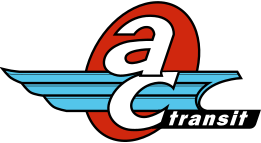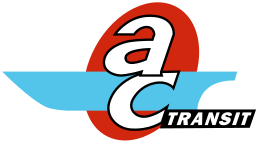User:Mliu92/sandbox/AC Transit fleet

The Alameda-Contra Costa Transit District (AC Transit) bus fleet, serving the counties of Alameda and Contra Costa, is the third-largest in California. It was initially formed in 1960 with a mixture of gasoline and diesel-powered buses purchased from its immediate predecessor, the privately-owned Key System. The first new buses were purchased for AC Transit in 1960, shortly after its formation and the GM New Look buses were delivered later that year. The transit agency operated GM buses exclusively until 1974, when the first Flxible New Look buses were ordered. Since then, AC Transit has ordered and operated buses from most of the major North American transit bus manufacturers, including Flyer, Gillig, Motor Coach Industries, Neoplan USA, and North American Bus Industries, as well as Van Hool, a Belgian bus supplier.
AC Transit has four operating divisions where buses are stored and light maintenance is performed, one central maintenance facility for major overhauls, and a general office in downtown Oakland, California.
Summary
[edit]AC Transit is the third-largest bus-only transit agency in California, carrying an average of 200,000 riders per weekday on 149 service lines, with 20,000,000 miles (32,000,000 km) miles of annual revenue service traveled by its fleet of buses.[1]: 1
Active
[edit]| Year | Manufacturer | Model | Length (feet) |
Qty | Fleet Series | Fuel | Image |
|---|---|---|---|---|---|---|---|
| 2003 | MCI | D4500 | 45 | 39 | 6041-6079 | Diesel | |
| Van Hool | A330 | 40 | 98 | 1001-1110 | 
| ||
| 2006 | Van Hool | A300K | 30 | 51 | 5001-5051 | Diesel | 
|
| 2007 | Van Hool | AG300 (articulated) |
60 | 10 | 2101-2110 | Diesel | |
| 60 | 14 | 2151-2165 | 
| ||||
| 2008 | Van Hool | A300L | 40 | 27 | 1201-1227 | Diesel | 
|
| A300K | 30 | 39 | 5101-5139 | Diesel | 
| ||
| 2010 | Van Hool | AG300 (articulated) |
60 | 9 | 2191-2199 | Diesel | |
| A300L FC | 40 | 12 | FC4-FC16 | Hydrogen | 
| ||
| 2013 | Gillig | Low Floor | 40[3] | 65 | 1301-1365 | Diesel | 
|
| New Flyer | Xcelsior XD60 (articulated) |
60[4] | 23 | 2201-2223 | Diesel | ||
| Gillig | Low Floor | 40[5] | 54 | 6101-6155 | Diesel | 
| |
| 2014 | Gillig | Low Floor | 40 | 68 | 1401-1468 | Diesel | |
| 2015 | ElDorado National | Aerotech 220 | 24 | 10 | 3501-3510 | Diesel | 
|
| 2016 | Gillig | Low Floor | 40 | 55 | 1501-1555 | Diesel | |
| Low Floor[6] | 40 | 25 | 1556-1580 | Diesel-Electric Hybrid | |||
| 2017 | Low Floor | 40 | 10 | 1581-1590 | Diesel | ||
| 2018 | Alexander Dennis | Enviro500 | 40 | 15 | 6201-6215 | Diesel | 
|
| New Flyer | Xcelsior XD60 (articulated) |
60 | 29 | 2224-2252 | Diesel | ||
| 2019 | Gillig | Low Floor HEV | 40 | 1 | 1591 | Diesel-Electric Hybrid | |
| Gillig | Low Floor | 35[7] | 1601-1635 | Diesel | |||
| New Flyer | Xcelsior XDE60[a] (articulated) |
60 | 27[7] | 2301-2327 | Diesel-Electric Hybrid | 
| |
| New Flyer | Xcelsior XHE40 | 40 | 10[7] | 7017-7026 | Hydrogen Fuel Cell | 
| |
| New Flyer | Xcelsior XE40 | 5[7] | 8001-8005 | Battery Electric | 
| ||
| New Flyer | Xcelsior XHE60 (articulated) |
60 | 1[7] | 2501 | Hydrogen Fuel Cell[b] |
- Notes
- ^ BRT model, used on Tempo BRT service
- ^ pilot program
Future Fleet
[edit]| Year | Manufacturer | Model | Length (feet) |
Quantity | Fleet Series | Fuel | Image | Notes |
|---|---|---|---|---|---|---|---|---|
| 2020-2024 | MCI | D45 CRT LE [8] | 45 | 137 (50 to be used by AC Transit) | TBD | Diesel |
Retired
[edit]| Year | Manufacturer | Model | Length (feet) |
Qty | Fleet Series | Preserved | Fuel | Image |
|---|---|---|---|---|---|---|---|---|
| ex-Key System buses | ||||||||
| 1941–42 | White | 788[a] | 33 | 23 | 815-898[b] | Gasoline | 
| |
| 1944–45 | White | 798[a] | 35 | 91 | 900-999[c] | Gasoline | ||
| 1947–48 | White | 798[a] | 35 | 75 | 1000-1074 | Gasoline | ||
| 1947 | Mack | C-41-GT[a] | 33' 2" | 60 | 2501-2560 | Gasoline | 
| |
| 1946 | GM | TGM-3609 Old Look[a] | 30' 9" | 45 | 1300-1344 | Gasoline[d] | ||
| 1946 | GM | TGM-3609 Old Look[a] | 30' 9" | 20 | 1200-1241 | Diesel[e] | ||
| 1947 | GM | TDH-4008 Old Look[a][f] | 33 | 5 | 1401-1405 | Diesel | 
| |
| 1944 | GM | TD-4006 Old Look[g] | 33 | 5 | 1500-1504 | Diesel | ||
| 1940–41 | GM | TD-4001 Old Look[h] | 33 | 4 | 1501-1504 | Diesel | ||
| 1947–48 | GM | TDH-4507 Old Look[a][f] | 35 | 175 | 1700-1874[i] | Diesel | 
| |
| 1949 | GM | TDH-4509 Old Look[a] | 35 | 25 | 1900-1924 | 1921[j] | Diesel | 
|
| 1950–51 | GM | TDH-5103 Old Look[a] | 39' 6" | 50 | 2000-2049 | Diesel | ||
| 1958 | GM | TDH-4801 Old Look[a] | 37' 6" | 21 | 2100-2120 | 2103[k][l] | Diesel | 
|
| New buses purchased by AC Transit | ||||||||
| 1960–61 | GM | SDH-4501 New Look | 35 | 57 | 100-156 | 100[m] | Diesel | 
|
| 1961 | GM | SDM-4501 New Look | 35 | 5 | 300-304[n] | Diesel | ||
| 1961 | GM | TDH-4516 New Look | 35 | 50 | 400-449 | Diesel | 
| |
| 1961 | GM | TDH-5301 New Look | 40 | 125 | 500-624 | Diesel[o] | 
| |
| 1961–62 | GM | TDH-4517 New Look | 35 | 43 | 700-712; 720-749 | Diesel | 
| |
| 1963–66 | GM | TDH-5304 New Look | 40 | 65 | 300-364 | Diesel | 
| |
| 1963–66 | GM | TDH-4519 New Look | 35 | 55 | 750-804 | Diesel | 
| |
| 1968–69 | GM | T6H-5305 New Look | 40 | 55 | 626-680 | Diesel | 
| |
| 1968 | GM | T6H-4532 New Look | 35 | 5 | 805-809 | Diesel | ||
| 1971–72 | GM | T6H-5305 New Look | 40 | 90 | 900-989 | Diesel[p] | 
| |
| 1973 | GM | T6H-5307N New Look | 35 | 55 | 810-864 | 839[q] | Diesel[p] | 
|
| 1961 (1974) | GM | TDH-4517 New Look | 29 | 13 | 700S-712S[r] | Diesel | 
| |
| 1974 | Flxible | 53102 New Look | 40 | 120 | 180-299 | Diesel | 
| |
| 1975 | Flxible | 53102 New Look | 40 | 36 | 8000-8035[s] | Diesel | 
| |
| 1976 | Minibus | MBD-8002 | 25 | 29 | 2200-2228 | Diesel | 
| |
| 1978 | M.A.N. | SG 220 (articulated) |
60 | 30 | 1600-1629 | Diesel | 
| |
| 1980–82 | Flyer | D901[t] | 40 | 170 | 1000-1169[u] | Diesel | 
| |
| 1980 | Flyer | D901[t] | 35 | 20 | 2000-2019 | 2013[v] | Diesel | |
| 1982–84 | Gillig | Phantom | 40 | 226 | 1300-1390; 1400-1483; 1485; 1500-1549[w] | Diesel | 
| |
| 1982–83 | Gillig | Phantom | 35 | 51 | 2049-2099 | Diesel | ||
| 1983 | Neoplan | AN440 | 40 | 61 | 1200-1260 | Diesel | 
| |
| 1984 | Neoplan | AN408 | 26 | 3 | 2300-2302 | Diesel | ||
| 1983 | M.A.N. | SG 310 (articulated) |
60 | 15 | 1630-1644[x] | Diesel | 
| |
| 1983 | Crown-Ikarus | 286 (articulated) |
60 | 15 | 1700-1714[x] | Diesel | ||
| 1988 | New Flyer | D35HF | 35 | 29 | 2400-2428 | Diesel | 
| |
| 1988–89 | New Flyer | D40HF | 40 | 79 | 2500-2578 | Diesel | 
| |
| 1989 | New Flyer | D60HF (articulated) |
60 | 30 | 1800-1829 | Diesel | ||
| 1990 | Gillig | Phantom | 40 | 52 | 2601-2652 | Diesel | ||
| 1992 | Gillig | Phantom | 30 | 62 | 2701-2762 | 2738[l] | Diesel | 
|
| 1993 | Gillig | Phantom | 40 | 60 | 2801-2860 | Diesel | ||
| 1997 | New Flyer | D60HF (articulated) |
60 | 30 | 1901-1930 | Diesel | 
| |
| 1997–98 | NABI | 416 | 40 | 204 | 2901-2971; 3001-3067; 3101-3166 | Diesel | 
| |
| 2000 | MCI | D4500 | 45 | 5 | 6001-6030 | Diesel | ||
| 2001 | MCI | D4500 | 45 | 2 | 6031-6040 | Diesel | 
| |
| 2000–02 | NABI | 40-LFW | 40 | 84 | 4001-4021; 4051-4090;[y] 7201-7223 | Diesel | 
| |
| 2003 | Van Hool | AG300 (articulated) |
60 | 30 | 2001-2057 | Diesel | 
| |
- Notes
- ^ a b c d e f g h i j k Purchased from Key System in 1960.[10]: 55–60
- ^ Discontiguous range. 815, 816, 821, 822, 826, 831, 832, 837, 843, 854, 859, 864, 865, 867, 873, 875, 881, 884, 885, 887, 895, 896, and 898.[10]: 60
- ^ Discontiguous range. 901, 918, 923, 939, 942, 954, 962, 972, 979 not purchased.[10]: 60
- ^ 20 buses were repowered with diesel engines, renumbered into 1200 series
- ^ 20 buses were repowered with diesel engines in 1961, renumbered directly from former 13xx fleet numbers: 1200, 1202, 1203, 1205, 1209, 1212, 1213, 1215, 1217, 1220, 1224, 1228, 1230, 1232, 1233, 1234, 1235, 1236, 1238, and 1241.
- ^ a b Originally built for Omaha & Council Bluffs Railway, traded to Key System in 1951.
- ^ Purchased from Long Beach to provide parts for diesel conversion of 13xx. Used for storage afterwards.
- ^ Purchased from Fresno City Lines to provide parts for diesel conversion of 13xx. Originally from San Diego. Some were rebuilt and used for revenue service.
- ^ 1700-1859 were originally purchased by Key System; 1860-1874 were ex-Omaha buses.
- ^ Repainted in Key System livery in 1980, overhauled in 1995.[2]
- ^ Loaned to Santa Clara County Transit District in 1979 for training, retired in 1980. Repainted in Key System livery in 1980, restored in 1995.[2]
- ^ a b At Pacific Bus Museum.[12]
- ^ Retired in 1983, returned to AC Transit in 1996/97.[2]
- ^ Renumbered to 175-179 in 1963.
- ^ Replaced the 8xx, 9xx, 10xx White-manufactured buses purchased from Key System.
- ^ a b Fitted with Environmental Improvement Kit to control smog-forming emissions.[11]
- ^ Purchased by Ron Hook in 1989, traded back to AC Transit.[2]
- ^ Shortened from 700-712 for on-demand service; 708 served as the prototype.
- ^ Originally purchased under a contract with BART for shuttle service and painted in BART colors; after the contract was canceled, repainted in AC Transit livery.
- ^ a b Purchased after a contract with GMC for RTS buses fell through.
- ^ Nos. 1155-1169 were built in 1982, without air conditioning.
- ^ Stored after retirement in 1997.[2]
- ^ 1500-1549 were originally purchased for BART contract service and repainted into AC Transit livery at the end of that contract.
- ^ a b Originally built for VTA, sold to AC Transit in 1988.
- ^ 4089 and 4090 do not have a back window
Experimental and prototype
[edit]| Year | Manufacturer | Model | Length (feet) |
Qty | Fleet Series | Fuel | Image |
|---|---|---|---|---|---|---|---|
| 1966 (1958) | Kässbohrer A.G. | Super Golden Eagle | 60 articulated | 1 | XMC-77[a] | Diesel | 
|
| 1967 | GM | TDH-5303 New Look | 40 | 1 | XMC-53 (625)[b] | Diesel | 
|
| 1971 (1969) | GM | T6H-5305 New Look | 40 | 1 | 666[c] | Steam | 
|
| 1973 (1961) | GM | TDH-4517 New Look | 29 | 1 | 708S[d] | Diesel | 
|
| 1983 | Neoplan | Skyliner | 40 | 1 | [e] | Diesel | 
|
| 1986 (1963) | GM/Flyer | TDH-5304 New Look & D901 | 40 | 1 | 311[f] | Diesel | |
| 1999 | APS Systems | Custom low-floor | 40 | 1 | 999[g] | Propane-Electric | 
|
| 2002 | Thor | ThunderPower | 30 | 1 | 4285[h] | Hydrogen | 
|
- Notes
- ^ Experimental articulated bus dubbed the "Freeway Train".[13] Trial began in March 1966.[14][15]
- ^ Originally built for Muni with GM's first eight-cylinder engine; after Muni testing was complete, tested by AC Transit and accepted into revenue service as 625.[16]
- ^ Developed under a 1969 grant.[17] Converted to and ran under steam power between Sept 27, 1971 and Sept 29, 1972. Power and acceleration were improved, but the reciprocating steam engine had higher fuel consumption.[18][19] Converted back to diesel after experiement concluded.
- ^ Sectioned and shortened to 29 feet (8.8 m) as a prototype for on-demand service.[20] The remaining 7xx series buses were also shortened.
- ^ Tested in April 1983. 73 seats total, 53 on upper level.[21]
- ^ Combined the chassis and cab of GM TDH-5304 #311 with the passenger section of a Flyer D901.
- ^ Battery electric bus with onboard propane-fired generator (Mazda 13B) for charging.[22] Tested in 1998; bus later tested by OCTA.[23]
- ^ Fuel cell bus initially built for SunLine Transit Agency. AC Transit tested the vehicle for one year starting in 2003.
History
[edit]
Key System inheritance
[edit]At its inception in 1960, AC Transit purchased the mixed White, Mack, and GM "old-look" bus fleet from its predecessor, the Key System. The 249 White, Mack, and GM gasoline buses were valued at US$508,000 (equivalent to $5,232,000 in 2023) and the 276 GM diesel buses were valued at US$2,612,700 (equivalent to $26,909,000 in 2023).[10]: 48, 55–56 189 gasoline buses manufactured by White were declared surplus in 1961 and were sold for US$60,000 (equivalent to $612,000 in 2023),[24] and the last gasoline-powered bus ran in revenue service on July 31, 1961,[25] although some of the newer gasoline-powered Macks were retained for lightly-traveled lines. Later in 1961, AC Transit began converting 10 of the GM old-look gasoline-powered buses to diesel using secondhand transmissions and engines.[26] The last of 26 Mack buses remaining in the fleet, #2510, ran a "farewell tour" on Line 43 in February 1965, decorated with painted tears and the message "To my friends, good-bye."[27]
New Look "Transit Liners"
[edit]
The first new buses ordered for AC Transit were 250 diesel GM New Look buses, which were delivered by late 1961. The cost per coach was US$34,420 (equivalent to $354,000 in 2023).[28] During the planning stage, the District announced plans to acquire 572 of these modern "Transit Liners" at an estimated cost of US$15,500,000 (equivalent to $159,637,795 in 2023).[29] AC Transit began New Look "Transit Liner" operation in late 1960.[30] The New Looks were credited with turning around ridership and revenue for the District. Many were equipped with air conditioning, and these proved especially popular in that first summer of operation, when high temperatures reached 110 °F (43 °C).[31]
AC Transit would continue to operate a mixed fleet of buses throughout the 1960s; the buses purchased from Key System started to be retired in 1969 (#1806 was the first diesel Old Look retired),[32] but were not fully retired until 1974 with the delivery of Flxible buses.[33][34] In 1969, the fleet consisted of 693 diesel-powered GM buses: 462 New Looks and 131 Old Looks.[35] AC Transit continued purchasing exclusively GM New Look buses through the early 1970s. In 1970, AC Transit announced that it would test GM's Environment Improvement Package (EIP), an emissions control retrofit consisting of a needle injector valve, catalytic muffler, air induction system, and rubber engine mountings; the District also noted it would participate in a steam-powered bus experiment, and was willing to evaluate electric- and turbine-powered buses.[36] The "low sac needle" injector was credited with reducing smoke by up to 93% and odors by a factor of 15.[37] The first EIP-equipped bus was assigned fleet #902 and entered revenue service in early 1971.[38] All the AC Transit New Look buses were fitted with the new injectors by November 1972.[39] In 1972, with the opening of BART, the District equipped all New Look buses with a blue light next to headsigns. The blue light was illuminated with the words "TO BART" when the bus was headed towards a BART station.[33]

In 1974, AC Transit ordered 120 Flxible New Look buses, its first purchase of new buses that had not gone to GM. Flxible had bid US$42,372 (equivalent to $262,000 in 2023) per bus in 1974, beating GM's bid of US$44,537 (equivalent to $275,000 in 2023).[40][41] In 1975, a second round of bids were solicited for 36 additional "deluxe" buses with reclining seats and air conditioning, intended for a BART contract to provide extension service to suburban areas. For the 1975 orders, inflation and additional equipment greatly increased the price.[41] Flxible submitted the winning low bid of US$71,108 (equivalent to $403,000 in 2023) per bus, beating GM's bid of US$75,144 (equivalent to $425,000 in 2023).[42] As it turned out, AC Transit would never receive another new bus from GM. Given the rise in bus prices, rather than replace the oldest Transit Liners (received in 1960), the District spent approximately US$2,700 (equivalent to $15,000 in 2023) per coach in 1975 to add standee windows and low-back seats, extending the life of the New Look fleet.[28][34]

In August/September 1976, AC Transit was one of ten agencies to participate in a group purchase of AM General/MAN SG 220 articulated buses, part of the first widespread deployment of articulated buses in North America once the orders began to be delivered in 1978.[43] After a fire in the Transbay Tube shut down BART service for several months starting on January 17, 1979, the AC Transit articulated buses were diverted to Transbay service.[44]
"Advanced Design" and dropping GM
[edit]
Models of three coaches designed by GM, American Motors, and Rohr Industries for the Transbus project were shown in 1973.[45] Although none of the Transbus project prototypes would ever go into production, AC Transit expressed an interest in acquiring the GMC RTS-II in 1975; the RTS-II "Advanced Design" coach was a direct descendant of the GM Transbus prototype.[46] In July 1976, AC Transit released requests for bids for the next generation of buses: 66 "Advanced Design" and several smaller coaches.[47] In September and October 1976, Flxible 870 and GMC RTS-II buses toured several East Bay cities; these "Advanced Design" coaches were being evaluated as potential replacements for the existing New Look fleet.[48] AC Transit ordered 66 RTS-II buses in May 1977 from GM[49] as part of a larger group purchase with five other operators. The purchase was allowed to proceed after a lawsuit by the losing bidder, AM General, was settled; the judge concluded the buses could be purchased without wheelchair lifts because of their limited reliability. The bid price was US$91,500 (equivalent to $460,000 in 2023) per coach.[50] However, AC Transit canceled the contract in 1979,[51][52] citing the high cost, which had risen to US$140,000 (equivalent to $588,000 in 2023) each, slow delivery (delivery had been expected in 1978), and fewer seats than the existing New Look buses.[53] The District rejected several RTS buses that had already been assembled; the completed buses were later sold to the Santa Clara County Transit District.[54]

Rather than pursue a set of "Advanced Design" buses, AC Transit chose to purchase buses with New Look-derived designs after the RTS contract was canceled;[52][53] AC Transit ordered 175 Flyer D901 buses in 35 and 40 ft (11 and 12 m) lengths. The per-unit cost was US$118,500 (equivalent to $497,000 in 2023) for a 40-ft coach.[55] The Flyer D901 fleet were the first AC Transit buses to be equipped with electronic route signs, along with kneeling suspension and a wheelchair lift.[56][57] 15 more Flyer D901s were added in 1982.[58]

By 1981, the District was once again soliciting bids for 60 "Advanced Design" buses; although the original "Transit Liner" New Looks delivered in 1960 were being replaced by the Flyer D901s, some of the Transit Liners still remained in service.[59] In 1982, AC Transit ordered 141 buses from Gillig and 60 from Neoplan;[58] the Gillig Phantom buses were updated New Look designs, while the Neoplan AN440 "Transliner" coaches were true "Advanced Design" buses.[60] The first Gillig, a 40-ft Phantom, arrived on site for testing in June 1982,[61] and AC Transit would place another order with Gillig for 134 additional coaches in 1983, at a cost of US$144,512 (equivalent to $442,000 in 2023) each.[62] With the Gilligs, AC Transit updated its livery from the "clownface" design first applied to the Transit Liners in 1960. The Neoplans were delivered in August and September 1982.[58]

AC Transit ordered 56 New Flyer D35HF and D40HF coaches in 1988 at an average cost of US$157,000 (equivalent to $404,000 in 2023) each to replace some of the oldest GM New Looks. The New Flyers were assembled in the local Union City plant.[63] The District added 52 more 40-foot D40HF coaches and purchased 30 D60HF buses to add to the articulated fleet in 1989;[64] the new D60HFs replaced 30 older articulated buses that had been temporarily leased from Santa Clara County Transit District.[65] Additional orders of Gillig Phantoms followed in the early 1990s, and a second round of 30 New Flyer D60HFs delivered in 1996 allowed AC Transit to retire the original AM General/MAN articulated buses.[66]

Starting in 1996, AC Transit added 204 Model 416 40-foot high-floor buses from North American Bus Industries (NABI).[66][67] The 416 was originally introduced in 1989 by American Ikarus as a domestic variant of the Ikarus 415 before the company was spun off in 1996 as NABI.[68]

AC Transit rolled out its first low-floor buses in 2000, when it received 44 NABI 40-LFW (040.70) coaches; a subsequent procurement of 40 low-floor coaches was originally awarded to Orion Bus Industries. The unit price was estimated at US$270,500 (equivalent to $465,000 in 2023), but during the course of negotiations, Orion insisted on using its own accessibility ramp rather than AC Transit's preferred vendor, and the per-unit price rose to US$308,000 (equivalent to $522,000 in 2023).[69] These factors tipped the award to NABI, and a second round of 40-LFW buses was procured instead.[70]

Also in 2000, AC Transit began operating a fleet of 45-foot over-the-road (suburban) coaches purchased from Motor Coach Industries beginning in the early 2000s.
Van Hool
[edit]In 2003, AC Transit began purchasing low-floor buses from Van Hool. The Van Hool buses were assembled in Belgium and featured low floors and three doors (four doors on articulated models), which AC Transit touted as the key to bus rapid transit service between Berkeley and San Leandro along Shattuck, Telegraph, International Blvd, and East 14th Street.[71]
After receiving criticism for the use of federal funds to purchase foreign-made Van Hool buses and tailored specification requirements to exclude domestic manufacturers,[72] AC Transit ordered locally-built Gillig buses in 2012.[73] In March 2013, AC Transit began operating the first of its new Gillig buses.[74] In August of the same year, AC Transit placed the first of its new New Flyer Xcelsior articulated buses into service.[4] Later that year, in November 2013, new Gillig buses with a suburban seating configuration and Transbay branding were introduced into service.[75]
All AC Transit buses are wheelchair accessible and have front-mounted bicycle racks. The MCI buses also feature luggage bay bicycle racks. AC Transit buses purchased after 2007 have air conditioning, as approved by the Board of Directors.[76]
Special types
[edit]
Articulated buses
[edit]AC Transit pioneered the use of articulated buses in the United States; in March 1966 it was the first transit agency to use the Super Golden Eagle long-distance coach (one of five originally designed and built for Continental Trailways; AC Transit designated it XMC-77 and called it the "Freeway Train"), primarily on Transbay service.[14]

By 1970, AC Transit was one of six agencies to participate in a "super bus project" coordinated by the National Transportation Center (Pittsburgh) to write a specification for a higher-capacity bus; once the specification had been written, two prototypes would be built and tested to select a winner for a large group procurement of 100 buses to keep per-unit costs low.[77] Two European-built articulated buses were tested in the summer of 1974: a Volvo B58, and a MAN SG 192.[78][79] Riders received the M.A.N. bus favorably, and the specification was released for bid in 1975;[80] AC Transit placed an order for 30 MAN SG 220 buses in 1976 and deliveries began from the AM General/M.A.N. joint venture in 1978.[81]
Alternative power
[edit]In 1969, AC Transit received a grant[82][83] and converted bus #666 to steam power, which ran in revenue service between 1971 and 1972. The propulsion system was designed by William Brobeck, who had previously worked on the Bevatron.[84] #666 used a triple-expansion closed-loop reciprocating steam engine; power was improved compared to the original six-cylinder Detroit Diesel 6V71 engine and emissions were reduced, but fuel consumption was higher than a conventional diesel bus.[17] Exhaust steam is condensed and returned to the steam generator, which is an externally-fired boiler that uses 1,400 feet (430 m) of coiled steel tubing,[19] generating steam at 850 °F (454 °C) and 800 psi (5,500 kPa).[85] Prior to entering service, the steam bus was exhibited in Washington DC[86] and to the public.[87] Bus #666 completed 3,403 miles (5,477 km) in revenue service when the trial ended in September 1972,[88] and the diesel engine was subsequently reinstalled in the bus.[89]
AC Transit is the lead agency of Zero Emission Bay Area (ZEBA), a consortium of five Bay Area transit agencies (AC Transit, Golden Gate Transit, SFMTA, SamTrans, and VTA) demonstrating fuel cell buses.[90] The District began the HyRoad program in 1999 and tested several fuel cell buses with new hydrogen fuelling infrastructure, including the Ballard/XCELLSiS ZEbus (a New Flyer F40LF with a Ballard fuel cell) in November 1999.[91] Three hydrogen-powered buses, based on the Van Hool A330, operated in revenue service from 2006 to 2010. AC Transit took delivery of 12 additional third-generation fuel cell buses, based on the Van Hool A300L, in 2011. Between 2003 and 2018, AC Transit zero-emissions buses traveled more than 3,200,000 miles (5,100,000 km) in revenue service.[1]: 2
Livery
[edit]By September 1960, AC Transit had selected the "wing" logo[92] along with a color palette that included silver, "Tahoe turquoise", "Monterey cypress green", and "persimmon orange."[93] The buses purchased from Key System were repainted from their original "fruit salad" colors to the "clownface" livery in 1960 and 1961,[26] featuring a predominantly white (upper half) and orange (lower front) color scheme with green side stripes, matching the newly-delivered New Looks.[94] The exterior design won a national award from Fleet Owner magazine in October 1961.[31][95] AC Transit retained the "clownface" livery for new orders through the Flyer D901s ordered in 1979.
-
Key System #1860 with legacy "fruit salad" livery
-
AC Transit #1811 purchased from Key System, repainted in "clownface" white/orange/green livery with turquoise/orange wing logo
-
AC Transit first-generation (TDH-5301) 40-ft GM New Look bus fleet in "clownface" with wing logo
-
Flxible New Look in "clownface" livery
-
Flyer D901 fleet in "clownface" livery
-
GM New Look repainted in "stripe" livery
The Gillig Phantoms and Neoplan AN440s ordered by AC Transit in 1982 were delivered with a more subtle "stripe" livery featuring the same three-color palette as the previous clownface livery. Some buses received a variant of the stripe livery, but the majority of new buses for the District bore the stripe livery, featuring orange and green horizontal stripes on predominantly white coaches. The wheels also lost their signature persimmon orange color with later orders. In the early 1990s, at least one bus (#1422) was painted as a test in a modified clownface livery featuring orange (bottom front) and green (top half) separated by a thin white stripe.[9]
In 2003, AC Transit rolled out an updated "ribbon" livery and logo featuring new colors (primarily white with green and black accents).[96] The suburban-type buses in Transbay service were painted in primarily green.
-
Gillig Phantom with "lightning" stripe livery variant
-
Gillig Phantom with "hills" stripe livery variant
-
NABI 416 with 1980s "stripe" livery and wing logo
-
NABI 40-LFW with updated "ribbon" livery, colors, and logo
-
MCI suburban coaches are primarily finished in green.
-
AC Transit #2152, Van Hool AG300 articulated in white with ribbon livery (2012)
Logos
[edit]-
"Arrowhead" masthead logo of the Alameda-Contra Costa Transit District (May 1958)
-
"Ring-and-arrow" logo (1958–1960)
-
"Wing" logo (1960–2003)
-
Simplified "wing", as painted on signs and buses (1960-2003)
AC Transit adopted its first official "ring-and-arrow" emblem around September 1958,[97] replacing an arrowhead logo that had been used on the masthead of its public newsletter Transit Times, first published in May 1958.[98] The ring-and-arrow logo was replaced in 1960 when AC Transit adopted the familiar "wing" logo, which was "designed to imply a sense of motion and speed" although the colors were not finalized until September of that year.[92][93] A simplified version of the wing logo was painted on buses and signs.
The wing logo was unchanged until 2003, when the District adopted a stylized green and gradient-gray "ribbon" logo,[96] which was later simplified in 2014 by dropping the gradient and updating the typeface.[99]
-
"Ribbon" logo (2003–2014)
-
Simplified "ribbon" logo (2014–present)
Facilities
[edit]| Name | 1 | 2 | 3 | 4 | 5 | 6 |
|---|---|---|---|---|---|---|
| Downtown Oakland[a][b] | Emeryville[b][c] | Richmond[c] | East Oakland[c][d] | Central Maintenance Facility[e] | Hayward[c][f] | |
| Image | 
|

|

|

|
||
| Address | 1600 Franklin St Oakland |
1177 47th St Emeryville |
2016 MacDonald Ave Richmond |
1100 Seminary Ave Oakland[g] |
10626 E.14th St Oakland |
1758 Sabre St Hayward |
| Size[101] | 100,000 sq ft (9,300 m2) |
392,000 sq ft (36,400 m2) |
266,000 sq ft (24,700 m2) |
579,500 sq ft (53,840 m2)[h] |
517,000 sq ft (48,000 m2) |
833,500 sq ft (77,430 m2)[i] |
| Capacity (buses)[101] | — | 147 | 90 | 160 | 650 | 170 |
Supported functions
| ||||||
AC Transit operates out of six major sites in Alameda and Contra Costa counties: four operating divisions to handle light maintenance, refueling, and bus storage; a central maintenance facility for major overhauls, procurement, and parts storage; and an administrative headquarters.[100]: 74
General Office
[edit]AC Transit administration started in the Alameda County Courthouse, and later moved to temporary quarters in the Claremont Hotel in September 1957 before moving back to downtown Oakland at the Plaza Building at 506 15th Street in January 1959.[102][103] With the purchase of Key System assets, AC Transit moved its General Offices (GO) into the Key System Building at 1106 Broadway in October 1960.[104][105] The GO moved again to the Latham Square Building at 508 16th Street in April 1963,[106][107] where it would stay for nearly 25 years. In late 1983, the District released a request for bids to build a new GO at 1600 Franklin, a site then occupied by a parking lot which had been purchased by AC Transit.[108] Groundbreaking on the new site began in April 1985,[109] and the first occupants moved into the 10-story building in June 1987. The building was built by private developers on public land, and a lease-to-own scheme meant the public would eventually own it as well.[110]
Central Maintenance Facility
[edit]The Central Maintenance Facility (CMF) is close to Seminary Division; the site was originally built as a warehouse for the adjacent Durant Motors Star factory[111] and was later used as a General Motors parts facility until it was purchased by AC Transit in 1980. Prior to the opening of CMF, major maintenance was performed at Emeryville Division.[112]
Operating divisions
[edit]The operating divisions are located in Emeryville (Division 2), Richmond (D3), East Oakland (also known as Seminary, D4), and Hayward (D6); an annex adjacent to Seminary is known as 66th Avenue or D4 Annex.[100]: 74 The Emeryville (D2), Richmond (D3), and East Oakland (D4) sites were acquired with the purchase of Key System assets in 1960.[113]
D6 originally opened in Newark to serve southern Alameda County routes in November 1975.[114] In 1981, AC Transit exercised an option to purchase a 17-acre (6.9 ha) site in Hayward from Mack Trucks to relieve overcrowding at the four operating divisions.[115] D6 moved from Newark to Hayward in October 1986; the training center at Hayward had opened in 1985.[111][116]
Richmond (D3) was closed in 2011 due to a serious fiscal crisis, and operations were moved to Emeryville.[117] In 2014, the economy had recovered and reopening Richmond was studied. Although closing D3 had the intended effect of reducing labor costs, the three remaining divisions were operating at or near capacity and service was suffering, as buses for northern routes had to be brought in from Emeryville.[118][119] Reopening Richmond would also increase operational flexibility, and AC Transit invested more than $15 million in improvements[120] before reopening D3 in 2017.[121]
In a 2018 study, AC Transit planners noted the four operating divisions were above their maximum bus capacity and presented a plan to remodel and expand three of the four operating divisions. Under the plan, Seminary (D4) would expand into a two-deck facility, taking advantage of an adjacent property owned by AC Transit on 66th Avenue and a potential purchase of a city-owned site to expand the total site area from 13.7 to 32 acres (5.5 to 12.9 ha) capable of holding 400 to 500 buses. A second division, known as Division 5, would be co-located at the expanded site.[101] In addition, the plan called for the relocation of the Central Maintenance Facility from D4 to D6 (Hayward), the Training and Education Center (TEC) would be relocated from D6 to D2 (Emeryville), and D2 itself would be moved to a new 28-acre (11 ha) site close to the MacArthur Maze at the corner of Burma St and Maritime Ave.
References
[edit]- ^ a b Zero-Emissions Bus Rollout Plan (PDF) (Report). 1. Alameda-Contra Costa Transit District. June 10, 2020. Retrieved 20 October 2020.
- ^ a b c d e f "Ridership, Bus Fleet and Service". AC Transit. Retrieved 23 January 2019.
- ^ "A Better Ride on AC Transit's Newest Buses" (Press release). AC Transit. Retrieved 20 October 2020.
- ^ a b "The New Flyers Are Here!" (Press release). AC Transit. August 12, 2013. Retrieved 20 October 2020.
- ^ "New Commuter Buses Launch November 8" (Press release). AC Transit. November 7, 2013. Retrieved 20 October 2020.
- ^ "AC Transit announces the launch of AC Go". AC Transit. 24 June 2016.
- ^ a b c d e "AC Transit Board Bus Fleet Update". AC Transit. 13 February 2019.
- ^ "AC Transit awards MCI five-year contract; receives notice to proceed for 36 MCI D45 CRT LE Commuter Coaches". Mass Transit Magazine. December 12, 2019. Retrieved February 26, 2020.
- ^ a b c Fitch, Bruce. "AC Transit Bus Roster". AC Transit. Retrieved 8 January 2019.
- ^ a b c d Arthur C. Jenkins & Associates (May 1960). Report on Valuation of Lands, Property and Rights of Key System Transit Lines as sought to be acquired by Alameda-Contra Costa Transit District (PDF) (Report). California Public Utilities Commission. Retrieved 22 January 2019.
- ^ "For cleaner air: Buses roll with anti-smog kits" (PDF). Transit-Times. Vol. 13, no. 7. AC Transit. January 1971. Retrieved 8 January 2019.
- ^ "Museum Roster". Pacific Bus Museum. Retrieved 23 January 2019.
- ^ "District to Experiment with Articulated 75-passenger Bus; Efficiency Gain Seen" (PDF). Transit-Times. Vol. 8, no. 6. AC Transit. October 1965.
- ^ a b "A New concept in Public Transit" (PDF). Transit-Times. Vol. 8, no. 11. AC Transit. March 1966.
- ^ "Articulated Bus Receives Enthusiastic Welcome During Introduction to Public" (PDF). Transit-Times. Vol. 8, no. 12. AC Transit. April 1966.
- ^ "Improved bus, with fast pick-up, more Power, to get trial on district lines" (PDF). Transit-Times. Vol. 9, no. 11. AC Transit. March 1967.
- ^ a b "Government grant gives financial Support to bus test of steam power" (PDF). Transit-Times. Vol. 11, no. 8. AC Transit. February 1969.
- ^ "Steam-powered bus being tested" (PDF). Transit-Times. Vol. 14, no. 4. AC Transit. October 1971.
- ^ a b "Introducing the modern steam bus" (PDF). AC Transit. 1971. Retrieved 7 January 2019.
- ^ "AC Transit shortens Bus for possible use in Dial-a-Ride operation" (PDF). Transit-Times. Vol. 16, no. 4. AC Transit. October 1973.
- ^ "Double-deck bus gets road tests" (PDF). Transit-Times. Vol. 25, no. 10. AC Transit. April 1983.
- ^ "Electric Vehicles". Clouser Engineering. Retrieved 9 January 2018.
- ^ Bowman, Catherine (February 13, 1998). "AC Transit to Test Electric Bus / 'Clean air' hybrid model runs 200 miles on a charge". San Francisco Chronicle. Retrieved 9 January 2019.
- ^ "Iron Horses of Bus Transportation Sold to Oakland Dealer for $60,000" (PDF). Transit-Times. Vol. 4, no. 1. AC Transit. May 1961. Retrieved 22 January 2019.
- ^ "Veteran Operator Wheels Last Gasoline Bus Across Bay Span; Diesels Take Over" (PDF). Transit-Times. Vol. 4, no. 4. AC Transit. August 1961. Retrieved 22 January 2019.
- ^ a b "Bus Modernization Ahead of Schedule With Big Savings" (PDF). Transit-Times. Vol. 4, no. 5. AC Transit. September 1961. Retrieved 22 January 2019.
- ^ "Gas-Powered Bus Rolls Into History" (PDF). Transit-Times. Vol. 7, no. 10. AC Transit. February 1965. Retrieved 22 January 2019.
- ^ a b "District refurbishing older coaches In effort to save public funds" (PDF). Transit-Times. Vol. 19, no. 5. AC Transit. November 1976. Retrieved 8 January 2019.
- ^ "facts you should know" (PDF). Alameda-Contra Costa Transit District. 1960. Retrieved 22 January 2019.
- ^ "First of Luxury 'Transit Liners' Enter Transbay Service on Christmas Day" (PDF). Transit-Times. Vol. 3, no. 8-E. AC Transit. December 1960. Retrieved 8 January 2019.
- ^ a b "New Look...New Deal...in the Bay Area" (PDF). GMC Truck & Coach. November 1961. Retrieved 22 January 2019.
- ^ "Deliver of new Buses send older Models to pasture" (PDF). Transit-Times. Vol. 11, no. 11. AC Transit. May 1969. Retrieved 8 January 2019.
- ^ a b "BART light designed for rider information" (PDF). Transit-Times. Vol. 15, no. 1. AC Transit. July 1972. Retrieved 18 January 2019.
- ^ a b "District refurbishing older coaches In effort to save public funds" (PDF). Transit-Times. Vol. 17, no. 9. AC Transit. March 1975. Retrieved 18 January 2019.
- ^ "District builds modern fleet with purchase Of new buses and additional radio units" (PDF). Transit-Times. Vol. 11, no. 7. AC Transit. January 1969. Retrieved 8 January 2019.
- ^ "For cleaner air: District moves ahead in smog fight" (PDF). Transit-Times. Vol. 12, no. 7. AC Transit. January 1970. Retrieved 18 January 2019.
- ^ "For cleaner air: District moves ahead in smog fight" (PDF). Transit-Times. Vol. 13, no. 4. AC Transit. October 1970. Retrieved 18 January 2019.
- ^ "For cleaner air: Buses roll with anti-smog kits" (PDF). Transit-Times. Vol. 13, no. 7. AC Transit. January 1971. Retrieved 18 January 2019.
- ^ "Low pollution fuel injectors Installed in "New Look" buses" (PDF). Transit-Times. Vol. 15, no. 5. AC Transit. November 1972. Retrieved 18 January 2019.
- ^ "Bus contract for 120 coaches Given to meet growing needs" (PDF). Transit-Times. Vol. 16, no. 9. AC Transit. March 1974. Retrieved 18 January 2019.
- ^ a b "Extension routes: New buses may be 'most expensive'" (PDF). Transit-Times. Vol. 17, no. 8. AC Transit. February 1975. Retrieved 18 January 2019.
- ^ "Flxible awarded contract For 36 deluxe buses" (PDF). Transit-Times. Vol. 17, no. 9. AC Transit. March 1975. Retrieved 18 January 2019.
- ^ "Operators train in bus-that-bends" (PDF). Transit-Times. Vol. 21, no. 4. AC Transit. October 1978. Retrieved 18 January 2019.
- ^ "Special Shuttle" (PDF). Transit-Times. Vol. 21, no. 7. AC Transit. January 1979. Retrieved 18 January 2019.
- ^ "TRANSBUS models displayed in Bay area; Viewers see featuers of 'Bus of the future'" (PDF). Transit-Times. Vol. 16, no. 3. AC Transit. September 1973. Retrieved 18 January 2019.
- ^ "District eyes 'Space Age' bus" (PDF). Transit-Times. Vol. 18, no. 4. AC Transit. October 1975. Retrieved 18 January 2019.
- ^ "Newly designed coaches sought" (PDF). Transit-Times. Vol. 19, no. 1. AC Transit. July 1976. Retrieved 18 January 2019.
- ^ "Newly designed buses tour District cities" (PDF). Transit-Times. Vol. 19, no. 4. AC Transit. October 1976. Retrieved 18 January 2019.
- ^ "Actions of the Board" (PDF). Transit-Times. Vol. 19, no. 11. AC Transit. May 1977. Retrieved 18 January 2019.
- ^ "Court clears the way for the District To purchase new advance design buses" (PDF). Transit-Times. Vol. 20, no. 3. AC Transit. September 1977. Retrieved 18 January 2019.
- ^ "Actions of the Board" (PDF). Transit-Times. Vol. 21, no. 12. AC Transit. June 1979. Retrieved 18 January 2019.
- ^ a b "Actions of the Board" (PDF). Transit-Times. Vol. 22, no. 01. AC Transit. July 1979. Retrieved 18 January 2019.
- ^ a b ""New look" buses to be added to fleet" (PDF). Transit-Times. Vol. 21, no. 12. AC Transit. June 1979. Retrieved 18 January 2019.
- ^ "GM RTS Production List: TH-8201". Ohio Museum of Transportation. August 13, 2004. Retrieved 22 January 2019.
- ^ "New buses ordered by District Directors to meet needs of wheelchair users, others too" (PDF). Transit-Times. Vol. 22, no. 02. AC Transit. August 1979. Retrieved 18 January 2019.
- ^ "First of 175 new buses arrive" (PDF). Transit-Times. Vol. 23, no. 04. AC Transit. October 1980. Retrieved 18 January 2019.
- ^ "Use grows of new access devices" (PDF). Transit-Times. Vol. 24, no. 01–02. AC Transit. July–August 1981. Retrieved 18 January 2019.
{{cite magazine}}: CS1 maint: date format (link) - ^ a b c "Older bus phase-out program progresses" (PDF). Transit-Times. Vol. 25, no. 01–02. AC Transit. July–August 1982. Retrieved 18 January 2019.
{{cite magazine}}: CS1 maint: date format (link) - ^ "Designs vary and choices are critical" (PDF). Transit-Times. Vol. 23, no. 8. AC Transit. February 1981. Retrieved 18 January 2019.
- ^ Alameda-Contra Costa Transit District 1983 Annual Report (PDF) (Report). AC Transit. 1983. Retrieved 25 January 2019.
- ^ "The Cover" (PDF). Transit-Times. Vol. 24, no. 12. AC Transit. June 1982. Retrieved 18 January 2019.
- ^ "Board gives big bus order to Gillig" (PDF). Transit-Times. Vol. 25, no. 10. AC Transit. April 1983. Retrieved 18 January 2019.
- ^ "Prototype gets good survey marks" (PDF). Transit-Times. Vol. 30. AC Transit. Spring 1988. Retrieved 18 January 2019.
- ^ "Coach order aids commuters, economy" (PDF). Transit-Times. Vol. 31. AC Transit. Spring 1989. Retrieved 18 January 2019.
- ^ Annual Report for the Year of 1988 (PDF) (Report). Alameda-Contra Costa Transit District. October 1988. Retrieved 27 January 2019.
- ^ a b Bithell, Bob (October 4, 2002). 02-268: Consider replacement and disposal of older buses and paratransit vehicles and review replacement schedule (PDF) (Report). AC Transit Board of Directors. Retrieved 27 January 2019.
- ^ "AC Transit GM Memo 06-864 Revised" (PDF). AC Transit. April 19, 2006. Retrieved 8 January 2019.
- ^ Brophy, Jim (July 23, 2016). "Bus Stop Classics: American-Ikarus/North American Bus Industries – From Hungary to Alabama…". Curbside Classics. Retrieved 27 January 2019.
- ^ Cannon, Pat; Babington, Carol (January 30, 2002). 02-037: Amend Authorization for the Award of a Contract to Purchase up to 40 Low-Floor Buses from Orion Bus Industries (GM Memo 01-283) (PDF) (Report). AC Transit Board of Directors. Retrieved 27 January 2019.
- ^ Draft Accessibility Advisory Committee Meeting Minutes (PDF) (Report). AC Transit. February 12, 2002. Retrieved 27 January 2019.
- ^ Gammon, Robert (January 23, 2008). "The Buses From Hell". East Bay Express. Retrieved 16 January 2019.
- ^ Gammon, Robert (January 23, 2008). "Belgium or Bust". East Bay Express. Retrieved 16 January 2019.
- ^ Gammon, Robert (March 30, 2012). "AC Transit Made Right Choice to Finally Buy Local". East Bay Express. Retrieved 16 January 2019.
- ^ "New Gillig Buses Start Service March 28" (Press release). AC Transit. March 28, 2013. Retrieved 20 October 2020.
- ^ "New Commuter Buses Launched" (Press release). AC Transit. November 7, 2013. Retrieved 20 October 2020.
- ^ "Installation of air conditioning on buses" (PDF). AC Transit. September 9, 2007. Retrieved 20 October 2020.
- ^ "Super bus project: Design sought for future coach" (PDF). Transit-Times. Vol. 13, no. 1. AC Transit. July 1970. Retrieved 8 January 2019.
- ^ "New services require maximum effort: Activity level reaches high peak in June" (PDF). Transit-Times. Vol. 16, no. 12. AC Transit. June 1974. Retrieved 16 January 2019.
- ^ "Riders may have chance To test two new articulated buses" (PDF). Transit-Times. Vol. 17, no. 1. AC Transit. July 1974. Retrieved 8 January 2019.
- ^ "'Superbus' preliminary specifications Out to manufacturers for review" (PDF). Transit-Times. Vol. 17, no. 8. AC Transit. February 1975. Retrieved 8 January 2019.
- ^ "Articulated coaches will ease Space crunch on heavily-used lines" (PDF). Transit-Times. Vol. 20, no. 12. AC Transit. June 1978. Retrieved 8 January 2019.
- ^ "Full steam ahead: District to test new power system" (PDF). Transit-Times. Vol. 11, no. 7. AC Transit. January 1969. Retrieved 8 January 2019.
- ^ "Government grant gives financial Support to bus test of steam power" (PDF). Transit-Times. Vol. 11, no. 8. AC Transit. February 1969. Retrieved 8 January 2019.
- ^ "Work starts on steam project" (PDF). Transit-Times. Vol. 13, no. 2. August 1970. Retrieved 10 January 2019.
- ^ "Steam bus project For AC Transit Nears completion" (PDF). Transit-Times. Vol. 13, no. 8. February 1971. Retrieved 10 January 2019.
- ^ "Steam Bus unveiled in Washington, D.C. Senators Cranston, Tunney among riders" (PDF). Transit-Times. Vol. 14, no. 5. November 1971. Retrieved 10 January 2019.
- ^ "Steam Bus unveiled to public" (PDF). Transit-Times. Vol. 14, no. 7. January 1972. Retrieved 10 January 2019.
- ^ "Steam bus project completed successfully After operation in revenue service" (PDF). Transit-Times. Vol. 14, no. 7. October 1972. Retrieved 10 January 2019.
- ^ "Steam bus reconverted As experiment ends" (PDF). Transit-Times. Vol. 14, no. 7. February 1973. Retrieved 10 January 2019.
- ^ "The HyRoad". AC Transit. Retrieved 10 January 2019.
- ^ "2". Short Range Transit Plan, FY2001-FY2010 (PDF) (Report). AC Transit. Retrieved 10 January 2019.
- ^ a b "Board of Directors Approves Official District Emblem; Replaces Key Symbol" (PDF). Transit-Times. Vol. 3, no. 4. AC Transit. August 1960. Retrieved 22 January 2019.
- ^ a b "New 'Transit Liners' on the Way" (PDF). Transit-Times. Vol. 3, no. 4. AC Transit. September 1960. Retrieved 22 January 2019.
- ^ "125 New Buses to Join Streamlined Transbay Fleet" (PDF). Transit-Times. Vol. 3, no. 9. AC Transit. January 1961. Retrieved 22 January 2019.
- ^ "AC Transit Awarded Top National Honor for New Equipment Color Design" (PDF). Transit-Times. Vol. 4, no. 6. AC Transit. October 1961. Retrieved 22 January 2019.
- ^ a b "Corporate Style Guide" (PDF). Alameda-Contra Costa Transit District. August 2003. Retrieved 16 January 2019.
- ^ "This is the official emblem adopted by the Alameda-Contra Costa Transit District" (PDF). Transit-Times. Vol. 1, no. 5. AC Transit. September 1958. Retrieved 22 January 2019.
- ^ "Transit on the Move: Monthly Newsletter to Tell Progress On Transit Planning for East Bay" (PDF). Transit-Times. Vol. 1, no. 1. AC Transit. May 1958. Retrieved 22 January 2019.
- ^ "Interim Branding Guidelines" (PDF). Alameda-Contra Costa Transit District. June 2014. Retrieved 16 January 2019.
- ^ a b c Short Range Transit Plan, Fiscal Years 2014/15 — 2023/24 (PDF) (Report). Alameda-Contra Costa Transit District. December 8, 2015. Retrieved 20 October 2020.
- ^ a b c Llamas, Salvador; Miyasato, Mika (August 29, 2018). "Facilities Utilization Plan & Zero Emission Bus Study" (PDF). AC Transit. Retrieved 23 January 2019.
- ^ "Transit Headquarters To Move in January" (PDF). Transit-Times. Vol. 1, no. 8. AC Transit. December 1958. Retrieved 18 January 2019.
- ^ "First Transit District Employee Leaves" (PDF). Transit-Times. Vol. 4, no. 2. AC Transit. May 1963. Retrieved 18 January 2019.
- ^ "District Headquarters To Be Moved Oct. 1 to Key's Oakland Offices" (PDF). Transit-Times. Vol. 3, no. 05. AC Transit. September 1960. Retrieved 18 January 2019.
- ^ "Public Help Asked in Locating Historical Plaque, Missing in Move to New Offices" (PDF). Transit-Times. Vol. 6, no. 1. AC Transit. May 1963. Retrieved 18 January 2019.
- ^ "New District Look" (PDF). Transit-Times. Vol. 5, no. 11. AC Transit. March 1963. Retrieved 18 January 2019.
- ^ "Ticket Office to Handle Passenger Transit Needs At Downtown Quarters" (PDF). Transit-Times. Vol. 5, no. 11. AC Transit. April 1963. Retrieved 18 January 2019.
- ^ "Developers to submit new GO plans" (PDF). Transit-Times. Vol. 26, no. 07. AC Transit. January 1984. Retrieved 18 January 2019.
- ^ "District headquarters Is among new buildings Altering city's skyline" (PDF). Transit-Times. Vol. 29, no. 09. AC Transit. March 1987. Retrieved 18 January 2019.
- ^ "Spacious site now welcomes customers" (PDF). Transit-Times. Vol. 29, no. 11–12. AC Transit. May–June 1987. Retrieved 18 January 2019.
{{cite magazine}}: CS1 maint: date format (link) - ^ a b "Antique desk is tie to transit's past" (PDF). Transit-Times. Vol. 31. AC Transit. Fall 1989. Retrieved 18 January 2019.
- ^ "Maintenance/Stores will share new facility" (PDF). Transit-Times. Vol. 23, no. 03. AC Transit. October 1980. Retrieved 18 January 2019.
- ^ "State PUC Approves Key Sale to District; Familiar Key Name Will Be Abandoned" (PDF). Transit-Times. Vol. 3, no. 05. AC Transit. September 1960. Retrieved 18 January 2019.
- ^ "New Division site opens this month" (PDF). Transit-Times. Vol. 18, no. 05. AC Transit. November 1975. Retrieved 18 January 2019.
- ^ "Board options Hayward site As possible transportation Facility to ease space needs" (PDF). Transit-Times. Vol. 24, no. 01–02. AC Transit. July–August 1981. Retrieved 18 January 2019.
{{cite magazine}}: CS1 maint: date format (link) - ^ "Hayward incorporates latest in transit operating technology" (PDF). Transit-Times. Vol. 29, no. 03. AC Transit. September 1986. Retrieved 18 January 2019.
- ^ 11-020a: Consider Decision to Close the District's Richmond Operating Division (D3) (PDF) (Report). AC Transit District Board of Directors. April 13, 2011. Retrieved 26 January 2019.
- ^ Armijo, David J. (February 12, 2014). 14-008: Consider Receipt of Report on AC Transit Facilities Utilization Assessment Study and Recommendations for the Division 3 Richmond Division (PDF) (Report). AC Transit District Board of Directors. Retrieved 26 January 2019.
- ^ Armijo, David J. (May 14, 2014). 14-107: Resuming Operations at Richmond Division (D3) (PDF) (Report). AC Transit District Board of Directors. Retrieved 26 January 2019.
- ^ Hursh, Michael A. (January 11, 2017). 17-009: Division 3 Rehabilitation Project Progress Report (PDF) (Report). AC Transit District Board of Directors. Retrieved 26 January 2019.
- ^ "AC Transit hosts grand reoping, open house and tour of Richmond-Division 3 bus facility" (Press release). AC Transit. January 27, 2017. Retrieved 26 January 2019.
External links
[edit]- "Alameda-Contra Costa Transit District". CPTDB wiki.
- "AC Transit Bus Roster (1960–2010)". AC Transit.
- "Ridership, Bus Fleet and Service". AC Transit.
- "Ridership, Bus Fleet and Service". AC Transit. February 2003. Archived from the original on April 22, 2003.
Categories


